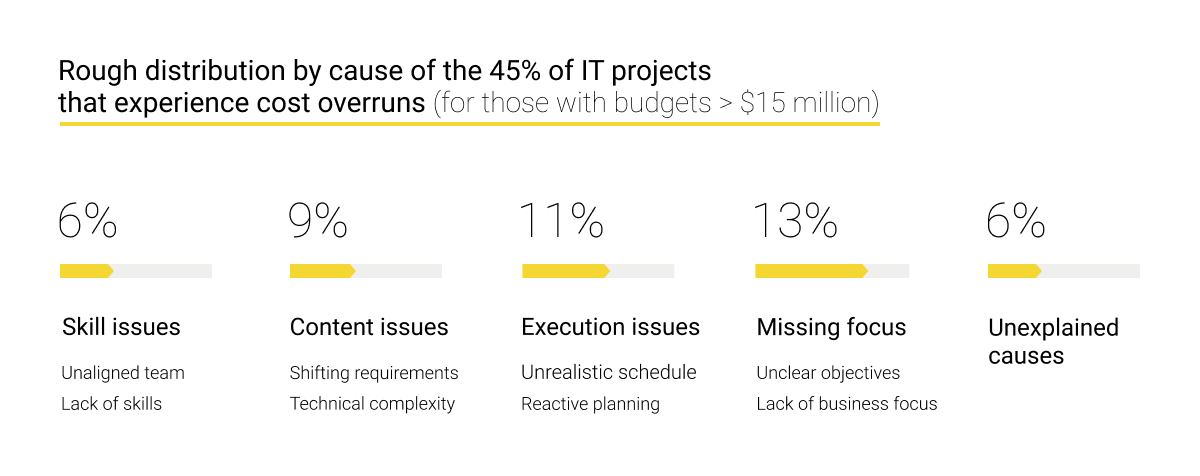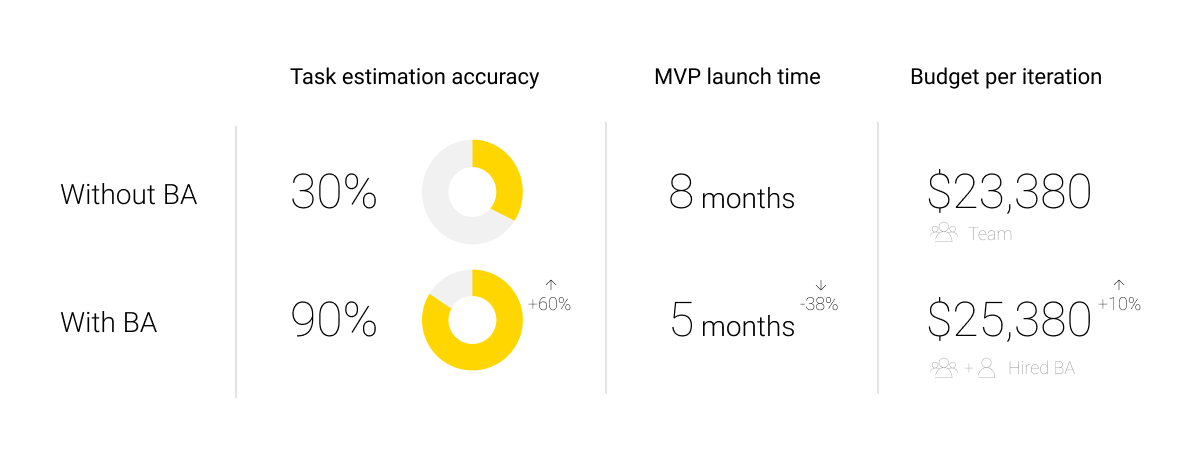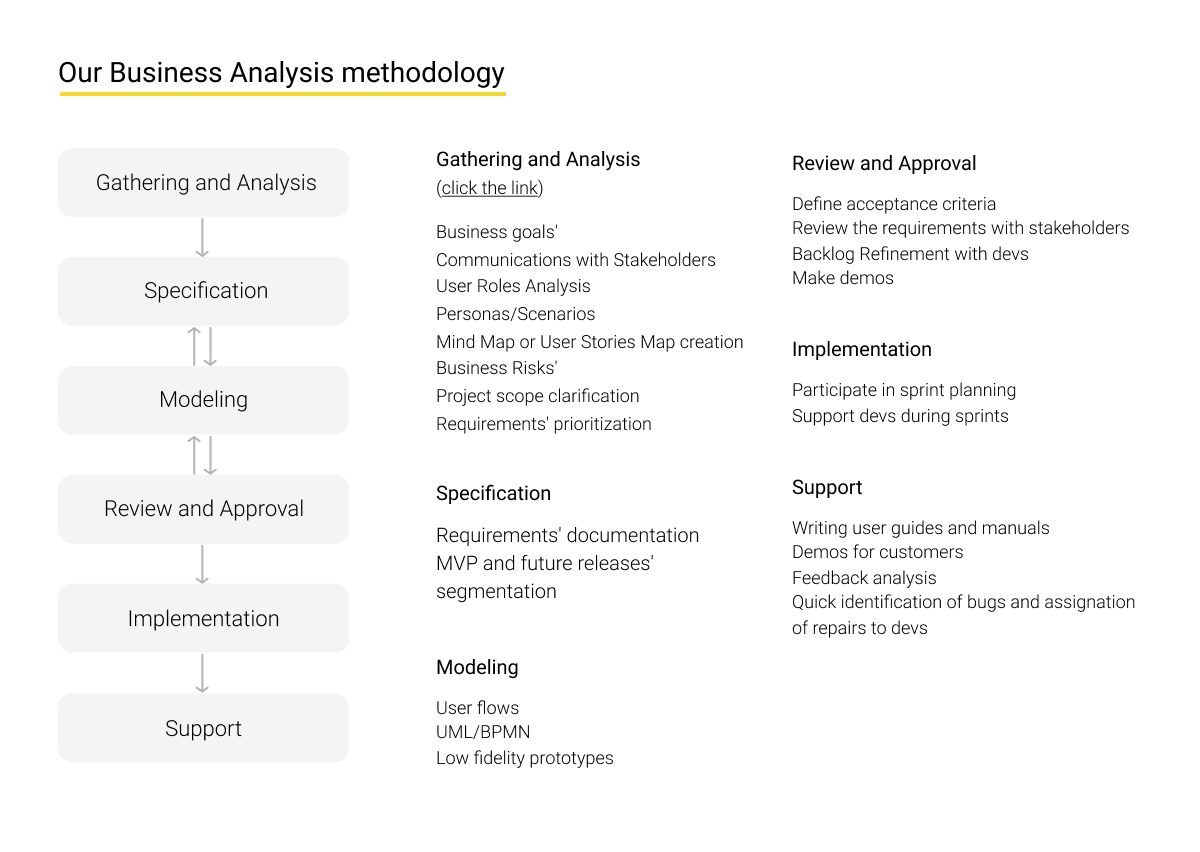- Why do the majority of projects fail?
- The importance of documenting requirements
- Three reasons why you should document the requirements
- Better project traceability
- Efficient troubleshooting
- Consistency of requirements
- What artifacts in software engineering are and how they help you reduce project costs
- Meeting agenda
- A follow-up email
- Vision & Scope document
- Software Requirements Specification
- User stories, user story maps, and use cases
- Andersen’s approach to documenting requirements
- Bottom line
Global digitalization is leading to a drastic increase in the number of software companies offering their services. However, statistically, 17% of IT projects fail, which leads to irreparable consequences for businesses, 7% of projects exceed their deadlines, and nearly half of them overrun their budget.

Analyzing business requirements increases the chances of finishing the project on time by 75% and allows business owners to save up to half of the project’s budget. In this article, Andersen’s experts will share why properly performed business analysis is important through the lens of artifacts in software development delivered by professional Business Analysts. Read on to learn how well-designed business analysis documentation can save your project and become an integral part of its success.
Why do the majority of projects fail?
There is a prevalent misconception among customers and shareholders from the business side that substantially prevents their product from achieving its goals and metrics. The conviction we are talking about is harmful to all the project participants as it leads to missed deadlines, overbudgeting, and a discrepancy between customer expectations and the developed product. In addition, the development team might despair as they have spent time in vain and now must rework the solution that has been already delivered.
The aforementioned delusion rests on the customer’s conviction that the project team can operate efficiently without having proper business analysis documentation. Customers believe that the success of their projects is achievable solely by the efforts of Project Managers and developers, overestimating their abilities to organize and manage the development process.
As a consequence, although your project might succeed without a dedicated Business Analyst in your team, it will definitely fail if nobody carries out their functions and works on the Business Analyst’s documents.
The importance of documenting requirements
Documentation management is one of the most important responsibilities of a Business Analyst. And for a good reason, as properly defined and well-documented requirements are crucial factors for achieving success.
According to research conducted by Meta Group, from 60% to 80% of projects’ failures can be attributed directly to poor requirements elicitation, management, and documentation. The findings provided by Carnegie Mellon University show that from 25% to 40% of all spending on projects is wasted as reworking is required, which is an expected consequence of neglecting the documents prepared by a Business Analyst.
Based on Andersen’s experience, we can state that proper business analysis documentation drawn up in the course of a Discovery phase increases customer satisfaction rates by providing them with software that meets all their needs while increasing user satisfaction rate by 75%.

Therefore, it is clear that a project without a specialist responsible for documenting requirements is doomed to fail.
Three reasons why you should document the requirements
Below are the most important reasons why analyzing business requirements and carefully documenting them during Project Discovery is crucial for a project.
Better project traceability
Thanks to the documents created by a Business Analyst, the team and stakeholders are on the same page regarding the developmental and testing processes. Everybody who is involved in the project knows exactly what needs to be done and what the project goals, scope, challenges, functional and non-functional requirements, and budget are.
The information both on specific tasks and on the general direction of work is always available. This allows the customer to stay up to date with the development process and even direct it. More importantly, structuring the requirements and storing them in one place make the project’s details clear to stakeholders, and therefore, the resulting product will meet their expectations to the fullest extent.
Efficient troubleshooting
Scope creep refers to the expansion of a project’s functionality that is beyond control. As a result, the development can substantially exceed the planned budget and timelines. This issue arises when the customers come up with many different ideas that haven’t been analyzed and prioritized by a dedicated specialist. This issue is found in about half of all projects, which means that only half of them are implemented on budget and within the timelines.
Meanwhile, carefully prepared business analysis documentation guarantees that, if your large-scale project expands, that can be easily controlled, and the developmental process won’t turn into a disaster due to multiple changes and gold plating.
Consistency of requirements
Keeping all the Business Analyst’s documents in one place ensures that the requirements can be restored even in case of data loss or data leakage. Such issues can occur when a team member leaves the project, the requirements become outdated, or if different sources contain contradictory information.
When the requirements are carefully documented, you as the customer can be sure that every idea, insight, and suggestion that was made is taken into account, analyzed, structured, documented, and updated by the team of experts.
What artifacts in software engineering are and how they help you reduce project costs
Artifacts are items created in the course of project development that don’t pertain to the product itself but help the team work on it. Business Analysts are responsible for the preparation of the following software engineering artifacts.
Meeting agenda
Description. Agenda is an artifact prepared before every meeting of the shareholders with the team and the meetings of the team members with each other. The goal of this artifact is to outline the key features of the forthcoming meeting. These meetings are conducted in order to elicit and specify the requirements, discuss important issues, and agree on a single vision for the product.
The meeting agenda includes the following information:
- general information about the meeting, i.e. its topic, time, location, and duration;
- the number of participants and their positions;
issues to be discussed;
- expected results;
- additional materials, e.g. preparatory documents.
Value. The agenda is extremely helpful in terms of making the meetings more productive as everybody knows the discussion plan and prepares for the event in advance. This artifact in software engineering saves the shareholders’ time allowing them to concentrate on the most important issues, meaning that more time will be spent on delivering value to the project.
Average preparation time: from thirty minutes to an hour.
A follow-up email
Description. This document summarizes the results of a meeting. It’s usually prepared in the format of an email which is compiled and sent to all the meeting participants after the meeting. Its purpose is to record the negotiation results and establish contact between everybody who was in the meeting.
Value. The follow-up email provides a clear vision of the development, including a recap of agreed items, proposed solutions, and received feedback. For the customer, it is a proven way to ensure that their position was rightly understood and the designed features will meet their expectations.
Average preparation time: from thirty minutes to an hour.
Vision & Scope document
Description. Different types of documents from a Business Analyst are required depending on the project’s specific needs. Each of the following documents covers a particular area of the project/product and has a different scope.
The Vision & Scope document consists of the following two parts:
- The vision part is a high-level description of a solution that needs to be delivered. This concept identifies current issues and the ways to solve them, business opportunities, and concomitant risks, and includes the metrics that will help you successfully reach your goals.
- The scope part specifies the amount of work to be done in order to achieve the goals. It lists project deliverables in the form of features developed in each release, basic assumptions, dependencies, the industry rules, and other limitations imposed on software.
Value. The Vision & Scope document helps all the stakeholders have the same vision of the project goals and a clear understanding of what needs to be done to achieve the needed outcomes. It allows the project participants to avoid misunderstandings early in the software development life cycle that could otherwise result in a costly and time-consuming rework.
Average preparation time: from two to four weeks.
Software Requirements Specification
Description. This extensive Business Analyst’s artifact contains detailed product information, including the methodologies that will be applied, the technology stack, functional and non-functional requirements, etc.
Value. SRS serves as a detailed plan for custom software development containing all the necessary information about the product’s functionality, features, and limitations. It helps both the customer and the IT vendor be on the same page regarding these important issues. The document contains precise requirements assessment and precedes the architecture and design stage. Such thorough planning allows the customer to avoid a costly rework and obtain accurate information as to the development cost, timelines, and risks.
Average preparation time: from four to eight weeks.
User stories, user story maps, and use cases
Description. A user story describes a software feature from a user's perspective and serves as a basis for collecting and documenting user requirements. It describes user types, needs, and expectations so that the developers can deliver a user-oriented product that brings value to end-users.
User stories are normally visualized in the form of user story maps. The latter allows the team to prioritize user stories and match them with the corresponding functionality.
A use case is a written description of a sequence of simple steps which the users take to perform the necessary actions. It outlines the system's behavior from a user’s point of view.
Value. All of the aforementioned software engineering artifacts allow Business Analysts to implement a user-driven approach to software design and ensure that the developed product satisfies the needs of end-users, thus, increasing the product’s popularity in the market.
Average preparation time: a user story/a use case — less than a day, a user story map — up to five days.
Andersen’s approach to documenting requirements
At Andersen, we have over 180 skilled Business Analysts continuously helping customers in Healthcare, FinTech, Logistics, Retail, and other major industries build high-performance software products.
Providing its customers with over ten types of business analysis documentation, Andersen’s experts will consult with you on the best matching documents that will thoroughly describe all your project requirements and help you reach your goals.
The following scheme describes the steps to be taken to draw up exhaustive and overarching documents, as well as some of the software engineering artifacts that add value to a project.

Bottom line
Business Analysts have a crucial role in a project, collecting, prioritizing, documenting, and updating the requirements, as well as creating key software engineering artifacts. Thus, they ensure that customers get the very outcomes they need, while the team will create an outstanding product on time, on scope, and within the timelines.
Andersen’s experts have over fifteen years of experience in analyzing business requirements, documenting functional requirements in business analysis, and performing other work essential for software projects’ success. Therefore, if you need professional help with creating an IT product of exceptional quality, do not hesitate to contact us.











